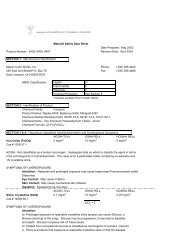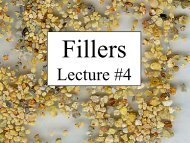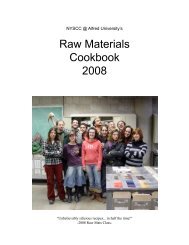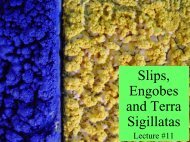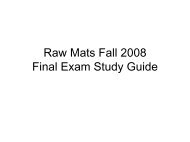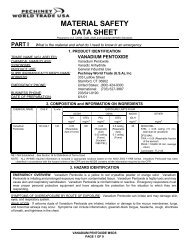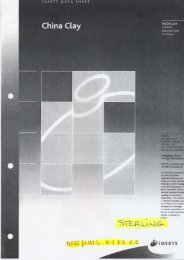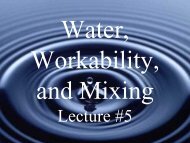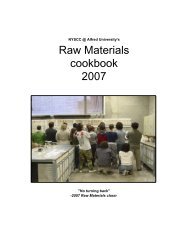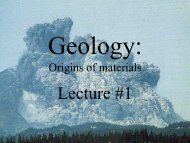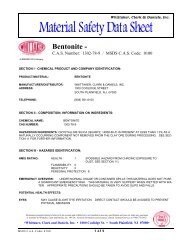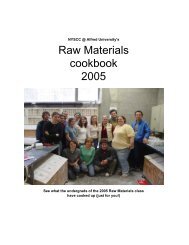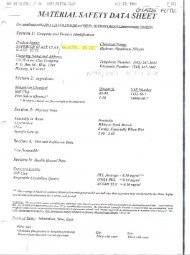Lecture #2 - Alfred's Clay Store
Lecture #2 - Alfred's Clay Store
Lecture #2 - Alfred's Clay Store
Create successful ePaper yourself
Turn your PDF publications into a flip-book with our unique Google optimized e-Paper software.
Mineralogy<br />
and <strong>Clay</strong><br />
<strong>Lecture</strong> <strong>#2</strong>
<strong>Lecture</strong> <strong>#2</strong><br />
• Basic chemistry<br />
• Silicate structures<br />
• <strong>Clay</strong> Minerals<br />
• <strong>Clay</strong> profiling
Ex. Oxygen<br />
Atoms
• Un-combined atoms are<br />
neutral in charge<br />
• Same number of electrons (-)<br />
and protons (+)<br />
Diagram of<br />
complete outer<br />
rings<br />
•However, atoms need<br />
their outermost shell to<br />
be full of electrons in<br />
order to achieve stability<br />
•In most cases, their outer<br />
shells are not completely<br />
filled when they are<br />
neutral so…
Ions<br />
An atom completes its outermost shell by losing, gaining, or sharing<br />
electrons from other atoms, in the process upsetting its original<br />
neutral charge and becoming a charged atom or “ion”<br />
_<br />
Atoms with many<br />
electrons in outer shell<br />
gain electrons to attain a<br />
complete outer shell<br />
+<br />
Atoms with few<br />
electrons in outer shell<br />
loose electrons to attain<br />
a complete outer shell<br />
Neutral<br />
Atom<br />
Unstable<br />
Charged<br />
Ion<br />
Stable
Valency<br />
• An atom’s valence refers to how many charges (electrons) an<br />
atom must loose or gain in order to fill its outermost ring<br />
• Elements in the same columns share a common valency
Valence<br />
• In order for atoms to balance each other during interaction,<br />
their valences must cancel out (must equal zero)<br />
E.g. Silicon = +4 Silicon = +4<br />
Oxygen = -2 so 2 x Oxygen = -4<br />
+2 0<br />
SiO SiO 2<br />
unstable<br />
stable
Ionic size is related to the number of<br />
electrons and the ionic charge<br />
Ionic Size<br />
+<br />
_
Co-ordination Configurations<br />
•The physical size of an atom dictates its stable arrangement with<br />
other atoms<br />
•The number of cations which can surround the smaller anion is<br />
called the co-ordination number; it is expressed as a ratio<br />
between the size of the cations and the anion
Si +4 radius = .41A<br />
O -2 radius = 1.32A<br />
Radius ratio = .41/1.32<br />
Or .31<br />
<br />
So…<br />
Crystals involving<br />
silicon and oxygen will<br />
always join in four-fold<br />
coordination<br />
(Tetrahedron)
The Silica Tetrahedra:<br />
the silicates’ most basic building block<br />
Tetrahedrons<br />
always have a<br />
–4 charge<br />
4 oxygen = -8<br />
1 silicon = +4<br />
Total charge –4<br />
Two separate<br />
Tetrahedra have<br />
A combined<br />
charge<br />
Of -8<br />
When they<br />
combine, they<br />
share an oxygen,<br />
and their<br />
combined charge<br />
drops<br />
7 oxygen = -14<br />
2 silicon = +8<br />
Total charge -6
• The more silica tetrahedrons combine and<br />
share oxygen with other tetrahedrons, the<br />
lower the combined negative charge<br />
becomes and the closer the structure comes<br />
to achieving electric stability (net zero<br />
charge)<br />
• When not enough tetrahedra are available to<br />
achieve a neutral charge through sharing of<br />
oxygen alone, neutrality is achieved through<br />
the presence of cations (positively charged<br />
ions)
Isolated Structures<br />
Olivine<br />
No oxygen is shared. Silica tetrahedra (-4) are bonded<br />
and neutralized by abundant Mg (+2) or Fe (+2) cations.
Single Chain Structures<br />
Spodumene<br />
Two oxygens of each tetrahedron are shared<br />
with adjacent tetrahedrons in a chain<br />
formation, reducing their net negative<br />
charge and the need for cations.
Sheet Structures<br />
Kaolinite<br />
Each tetrahedra shares three of its oxygens, forming a<br />
sheet. The left over negative charge is satisfied by a layer<br />
of aluminum, oxygen and hydrogen (A.K.A. Gibbsite)
Framework<br />
Quartz<br />
Feldspar<br />
All four oxygen atoms are<br />
shared by other tetrahedrons
<strong>Clay</strong> Minerals<br />
•Affect many properties of clay<br />
Plasticity<br />
Drying properties<br />
Composition<br />
Firing characteristics<br />
Color<br />
•We will look at kaolinite, illite, and montmorillonite as<br />
these predominate most of the clays we use
Kaolinite<br />
(Fine)<br />
Illite<br />
(Finer)<br />
Montmorillonite (Finest)
Kaolinite Crystal<br />
Tetrahedra<br />
•The main clay<br />
mineral in most clays<br />
(esp. Kaolins)<br />
Silica<br />
Alumina<br />
Silica<br />
Alumina<br />
Silica<br />
Alumina<br />
Octahedra
Kaolinite Crystal<br />
-Exploded View-<br />
Al<br />
Si<br />
•Each Aluminum shares<br />
Oxygen with two Silicon<br />
atoms, creating a strong<br />
internal bond<br />
•Hydroxide (OH) mediates<br />
the charge difference<br />
between Si and Al layers<br />
•1:1 sheet silicate<br />
1 Si :1 Al<br />
Chemical formula<br />
Al 2 O 3 • 2SiO 2 • 2H 2 O
Kaolinite Particle<br />
•Kaolinite particles are ten<br />
times wider than they are<br />
thick<br />
•They exhibit a positive and<br />
a negative charge on<br />
opposite planes which<br />
encourages stacking of<br />
individual layers
Stacking<br />
Individual crystals in a stacked formation
Kaolinite<br />
However, the attraction of<br />
crystal faces is relatively weak<br />
(easily separated with high<br />
energy blunging in water)
Feldspar<br />
Mica<br />
•The three<br />
minerals that<br />
make up a<br />
granite rock<br />
Quartz
Kaolinite Minerals Often Result<br />
From Feldspar Weathering
Kaolinization of feldspar<br />
• Example: Potash feldspar (K 2 O • Al 2 O 3 • 6SiO 2 )<br />
• Feldspar is soluble in water (H 2 O) and even more so in<br />
carbonic acid (H 2 CO 3 )<br />
• Water, carbon dioxide, and carbonic acid dissolve feldspar<br />
• Carbon, along with most potassium and some silica is<br />
carried away<br />
• Feldspar becomes kaolinite:<br />
Al 2 O 3 • 2SiO 2 • 2H 2 O
Environmental Factors Aiding in<br />
• Climate<br />
Kaolinite Formation<br />
– Rainfall/groundwater (carbonic acid/water)<br />
– Temperature (encourages organic activity)<br />
• Soil/vegetation<br />
– Thickness of soil layer (moisture retention)<br />
– Organic activity (physical breakdown/increase<br />
acidity)<br />
• Length of exposure<br />
– Age of deposit
Montmorillonite<br />
• Found in Bentonite (also in<br />
smaller amounts in some<br />
kaolins, ball clays,<br />
earthenwares, etc)<br />
• Produced by the weathering of<br />
volcanic rock, esp. fine<br />
volcanic ash<br />
• Finer/more plastic than Illite or<br />
Kaolinite<br />
• Expands in water<br />
• High Mg and Fe impurities<br />
within the crystal structure act<br />
as fluxes (lower melting temp.<br />
than kaolinite)
Montmorillonite<br />
Silica<br />
Alumina<br />
Silica<br />
Silica<br />
Alumina<br />
Silica<br />
Alumina<br />
Silica<br />
Silica<br />
Alumina<br />
Silica<br />
Alumina<br />
Silica<br />
Silica<br />
Alumina<br />
Montmorillonite<br />
2:1<br />
Sheet structure<br />
Kaolinite<br />
1:1<br />
Sheet structure
Silica<br />
Alumina<br />
Kaolinite<br />
1:1<br />
Silica<br />
Alumina<br />
Silica<br />
Montmorillonite<br />
2:1
Kaolinite vs. Montmorillonite<br />
-<br />
+<br />
-<br />
+<br />
-<br />
+<br />
Kaolinite<br />
Silica<br />
Alumina<br />
Silica<br />
Alumina<br />
Silica<br />
Alumina<br />
Stronger<br />
Oxygen/Hydrogen Linkage<br />
Non-expanding<br />
Montmorillonite<br />
-<br />
Silica<br />
Alumina<br />
Silica<br />
Silica<br />
Alumina<br />
Silica<br />
Silica<br />
Alumina<br />
Silica<br />
+<br />
-<br />
-<br />
+<br />
-<br />
-<br />
+<br />
-<br />
Weaker<br />
Interlayer space (water)<br />
Expanding<br />
•In Montmorillonite,<br />
faces are of similar<br />
charge<br />
•Negative edges are<br />
weakly bonded by<br />
positive cations (Na,<br />
Ca, or Mg)<br />
•Weakness of bond<br />
and large size of<br />
cations permits easy<br />
separation of stacked<br />
crystal faces<br />
•Water permeates<br />
layers (plasticity<br />
increases)<br />
•Crystal lattice<br />
expands (bentonites<br />
swell in water)
Illite<br />
• Usually comes from weathering of<br />
Mica<br />
– But contain more water and are much<br />
finer<br />
– Can also form from K-spars and<br />
Smectites<br />
• Finer/more plastic than Kaolinites<br />
• Often found in high % in lower-fire<br />
dark clays (I.e. Redart)<br />
• Illite’s presence is indicted by high K<br />
in clay analysis<br />
• High K acts as a flux (lower melting<br />
temp. than kaolinite)<br />
• 2:1 silicate (like Montmorillonite)<br />
Various different forms of Illite
Raw <strong>Clay</strong><br />
• Most clays, as dug from the ground, contain<br />
few amounts of pure clay minerals<br />
• Before processing, a raw clay contains:<br />
• Quartz<br />
• Micas<br />
• Feldspars<br />
• <strong>Clay</strong> minerals<br />
– Kaolinite<br />
– Montmorillonite<br />
– Illite<br />
– And many others …<br />
• Mined clays are processed<br />
80-85%<br />
10-15%<br />
Impurities<br />
<strong>Clay</strong><br />
– impurities are removed to increase the proportion<br />
of clay mineral content<br />
• Differences among raw clays reflect the different proportions of these<br />
clay minerals and impurities
Primary & Secondary <strong>Clay</strong>s<br />
• Primary clays<br />
– Some kaolins<br />
• <strong>Clay</strong>s that are found where they were formed<br />
• Involve little or no transportation<br />
• Also known as residual clays – they are the residue of<br />
their parent rocks<br />
• Secondary clays<br />
– All other clays (most kaolins, ball clays, stone<br />
wares, fireclays and earthenwares)<br />
• Involve transportation and deposit of primary clays<br />
• Also known as sedimentary clays<br />
• Much more common than primary clays
<strong>Clay</strong> Distribution<br />
Secondary Kaolins
Kaolin<br />
• Kaolinite: The predominant mineral in many clays<br />
Kaolin: A type of clay; A.K.A. China <strong>Clay</strong><br />
• Originally comes from Chinese “kao-ling” meaning<br />
high-ridge (where it was mined)<br />
• The raw clay that most closely resembles “ideal”<br />
Kaolinite mineral<br />
Al 2 O 3 • 2SiO 2 • 2H 2 O<br />
– Lowest impurities of all clays (fired whiteness)<br />
• Very refractory (melts @ cone 34-35; 1770°C)<br />
• Mature @ ca. cone 12-18
• Mainly coarse particles<br />
• 1 micron = 1/1000 mm (60 mesh screen = 250<br />
microns)<br />
• Ball clay range: 0.02 - 1 microns<br />
• Kaolin range: 0.5 - 10 microns<br />
Ball <strong>Clay</strong><br />
0.02 1<br />
Kaolin<br />
0.5 10<br />
Kaolin<br />
• Relatively non-plastic<br />
• Widely used in china production BUT principally used<br />
as a white coating on paper (80% of kaolin market)
Primary/Residual Kaolins<br />
Decompose where their parent rock once was<br />
-Little or no transport / minimal impurities<br />
– Fire white/off-white<br />
• Low plasticity<br />
– Generally coarse particles (10-5 microns)/well<br />
crystallized (large crystals)<br />
– Uniform particle size and shape<br />
• Major deposits: Japan, China, Korea, India,<br />
England, Germany<br />
Ex. Grolleg, SSP, Polaris etc…(no major US production)
Secondary/Sedimentary Kaolins<br />
More transport/more impurities than primary kaolins<br />
• Finer particles/greater range of particle sizes (aka.<br />
Particle size distribution) due to geological transport<br />
– Particle range: 5-.5 microns<br />
– Higher plasticity: A.K.A “Plastic Kaolin” (small<br />
Montmorillonite content)<br />
• More contaminants, especially Ti & Fe<br />
• Fire white/off-white<br />
• South Carolina and Georgia are the main US sources<br />
(others include NC, KY, TN & FL)<br />
Ex. Tile 6, Helmer, EPK etc…
Primary Kaolin Deposits
Primary Kaolin Deposits<br />
Secondary Kaolin Deposits
Kaolins<br />
• Primary<br />
– Grolleg<br />
– SSP (Super Standard Porcelain)<br />
– Polaris<br />
• Secondary<br />
– EPK (Edgar Plastic Kaolin)<br />
– Tile-6<br />
– Helmar<br />
– Velvacast<br />
– Peerless<br />
– Kaopaque
Kaolin<br />
• Pros<br />
– White (low impurity levels)<br />
– Coarse (improves drying characteristics)<br />
• Cons<br />
– Typically expensive<br />
– Coarse (low plasticity/low green strength)
Ball <strong>Clay</strong><br />
• “Ball” originates from the early English<br />
mining practice in which plastic clay was cut<br />
from its deposit in the form of large balls.<br />
• Mainly Kaolinite minerals but can also contain<br />
large amounts of Illite and Montmorillonite<br />
• Transported and deposited from earlier kaolin<br />
deposits<br />
• Fine particle size (60-70% under 1 micron)<br />
– Highly plastic (higher than kaolins)<br />
• Rarely used alone in a clay body
Ball <strong>Clay</strong><br />
• Contain higher amounts of impurities (iron,<br />
calcium, quartz) than kaolins<br />
– Mostly off-white to cream color after firing<br />
– Vitrify in the cone 03-4 range (but can go as<br />
high as cone 10)<br />
• Most contain 1-3% organic materials (because<br />
they are sedimentary)<br />
• Organics add to ball clay's plasticity<br />
• Readily accept ions from deflocculants, making<br />
them valuable in casting slips<br />
• Most US ball clays are mined in Kentucky and<br />
Tennessee
Ball <strong>Clay</strong>s<br />
• OM-4 (Old Mine #4)<br />
• XX Saggar<br />
• Spinks Blend<br />
• Jackson<br />
• Tennessee #10<br />
• KT Stone<br />
• C&C
Ball <strong>Clay</strong><br />
• Pros<br />
– Increase plasticity<br />
– Help suspend slips<br />
– Increase wet and dry strength (particle packing)<br />
– Easy to deflocculate (slip casting)<br />
• Cons<br />
– Increase dry shrinkage<br />
– Often too dark for a true “White” body<br />
– Too sticky by themselves<br />
– Can impede evaporation when leatherhard (slower<br />
casting and drying rates)<br />
– High amounts of free silica (firing related issues)
Fireclay<br />
• So named because some (though not all) resist fire<br />
-Firing range 1300-1800 C (cone 6-22)<br />
• Usually more Illite than Kaolinite minerals<br />
• Generally coarse particle size<br />
– Provide firm, toothy quality to bodies<br />
– Open structure / quick drying<br />
Originally acted as soil for vegetation and are<br />
therefore usually found underneath coal seams<br />
– Plants remove potassium and other soluble salts<br />
– Plants also remove some trace silica but no alumina.<br />
Thus fireclays are high in alumina and often refractory
Fireclay<br />
• Fireclays contain volatile impurities, including<br />
sulphur, carbon and carbon dioxide<br />
• Carbon derives from decomposed organic activity<br />
– Up to 3% carbon<br />
– Some fireclays actually contain carbonaceous matter<br />
like old plant roots, remnants of trees and other organic<br />
matter<br />
• Other impurities include<br />
– Free silica (quartz), sulphur (iron pyrite), mica, iron,<br />
and calcite (calcium carbonate)
Fireclay<br />
• Large pieces of Calcite in unrefined fireclays can lead to<br />
problems after firing<br />
– I.e. CaCO 3 pop-outs<br />
• Volatile impurities (carbon/sulphur) can be trapped if not<br />
fired properly<br />
– I.e. black coring or bloating<br />
• Typical post-fired color ranges from whites to pinks to<br />
reds<br />
– Iron leads to reds<br />
– Presence of calcium tints (leaches) iron, tinting red colors towards<br />
pinks<br />
• US sources<br />
– Kentucky, Ohio, Missouri, Pennsylvania
Fireclays<br />
• Narco (no longer carried here)<br />
• Hawthorn Bond 20<br />
• Hawthorn Bond 35<br />
• Hawthorn Bond 50<br />
• Gold Art<br />
• Christy Gold<br />
• A.P. Green (R.I.P.)
Fireclay<br />
• Pros<br />
– Refractory<br />
– Often available in a wide range of particle sizes<br />
(HB 20, 35, 45, 50 mesh)<br />
– Cheap! (inexpensive)<br />
– Cheaper alternative to grog<br />
• Cons<br />
– Lime pop-outs/carbon impurities (can be minimized by<br />
using 50 mesh and finer grades)<br />
– Not very clean<br />
– Limited plasticity/fineness
Stoneware<br />
• Not to be confused with a stoneware body (we<br />
will look at bodies latter)<br />
• Kaolinite and Montmorillonite minerals<br />
• Midway between ball clay and fire clay in<br />
plasticity, firing range, texture and color<br />
• Mixed particle size distribution<br />
– Toothy, yet plastic<br />
• Can be used w/o other clays in a clay body<br />
– Acceptable working characteristics “as is”<br />
• Extensively used throughout history<br />
• Mature between cone 4-10<br />
• Colors range from buff to tan to brown
Stonewares<br />
• Foundry Hill Cream (FHC)<br />
• Yellow Banks #101
Stoneware<br />
• Pros<br />
– Does the job of ball clay and fire clay<br />
– Inexpensive<br />
• Cons<br />
– High impurity levels
Earthenware<br />
• “Common Blue Collar <strong>Clay</strong>”<br />
– World wide use throughout history; often used straight<br />
from the ground<br />
• Also called “Brick <strong>Clay</strong>”<br />
• Varying amounts of Kaolinite and Illite<br />
• Extensive weathering and transport + varying<br />
sources and depositional environments<br />
– Wide range of chemical/physical properties<br />
• Typically contain high amounts of Iron (5-15%)<br />
along with Calcium and Titanium<br />
• Prefired colors range from black to ochre to red<br />
• Post fired colors range from bright orange to buff to black<br />
• White or cream colored when little Iron is present<br />
• Start to vitrify below 1200 (Cone 3-4)
Earthenware<br />
• Often contain soluble salts and organics<br />
• Wide distribution of particle sizes due to transport<br />
– Range from .5-5 microns<br />
• Wide distribution leads to good workability<br />
(combination of strength and plasticity)<br />
– Like stoneware clays, these can be used in large<br />
amounts “as is”<br />
• Widely distributed and mined throughout the US
Earthenwares<br />
– Red Art<br />
– Lizella<br />
– Barnard Black Bird (Substitute)<br />
– Alfred Shale<br />
– Newman Red (Substitute)<br />
• Slip <strong>Clay</strong>s:<br />
• (Higher flux levels of Ca, Mg & Fe)<br />
– @ Cone 04 • can be used for bricks<br />
– @ Cone 4-10 • used for glaze<br />
– Albany Slip (or Albany Slip Substitute)<br />
– Alberta Slip <strong>Clay</strong><br />
– Sheffield Slip <strong>Clay</strong>
Earthenware<br />
• Pros<br />
– Good plasticity and drying characteristics for<br />
modeling/throwing (due to fine/coarse particles)<br />
– Rich color variations<br />
• Cons<br />
– Scumming (soluble salts)<br />
– High Mn (Manganese) in some varieties may pose<br />
health risks<br />
– High temperatures and/or reduction atmospheres may<br />
cause excessive bloating/melting<br />
• Not suitable in large amounts for high temperature clay bodies<br />
– Can be difficult to deflocculate (slip-casting)
Bentonite<br />
• Named after Fort Benton, a major source of bentonite in<br />
the US<br />
• Typically originates from the decomposition of volcanic<br />
ash or lava flows<br />
• Contains montmorillonite rather that kaolinite<br />
• Extremely fine particle size (ten times finer than ball clay)<br />
– So fine that they are not measured in diameter but in surface area<br />
– Kaolin 16 m 2 /g (50lbs = 363,200 m 2 = 81 football fields)<br />
– Bentonite >100 m 2 /g (50lbs = 2,270,000 m 2 = 509 football fields)<br />
• Typical bentonite softens at 1040 C (cone 06-05) and fuses<br />
around 1336 C (cone 11)<br />
• Mainly mined in Wyoming and S. Dakota (ancient<br />
volcanic activity)
Bentonite<br />
• When added to water, bentonites swell (increase in<br />
volume) dramatically<br />
• Additions:<br />
– Typically 1-3% to improve plasticity<br />
– Up to 6% can be added to non-plastic porcelains<br />
• Macaloid / Vee-Gum<br />
– Based on the clay mineral Hectorite<br />
– Stronger effect on plasticity than bentonite (twice as<br />
strong)<br />
– Much whiter than bentonite<br />
– $$$$<br />
– Vee-Gum and Macaloid are trade names; both are a<br />
blend of Hectorite and organic gums
Bentonite<br />
• Pros<br />
– Add plasticity<br />
• Cons<br />
– Most are too dirty for true “white” bodies<br />
– High drying shrinkage<br />
– Must be thoroughly mixed and/or blunged (can<br />
cause drying problems if not properly<br />
dispersed)
Scanning Electron Micrograph (SEM)<br />
Note the well developed hexagonal crystals in these Georgia kaolins
AP Green at the same scale as OM-4<br />
OM-4<br />
AP Green<br />
Ball clay (OM-4) contains much finer crystals than fireclay (AP Green)
Wide particle distribution range of an earthenware (Red-Art)
Montmorillonite crystals in this bentonite are too fine to be seen
Chemical analysis of clay (cheat sheet)<br />
• Low SiO 2 (30%)<br />
– Refractory (resists melting)<br />
• High K 2 O (>2.5%)<br />
– High Illite, and possibly quite plastic<br />
• High MgO<br />
– Possibly high in montmorillonite (and therefore, plastic)<br />
• High Al 2 O 3 (>30%) and less than 3% of K 2 O CaO, MgO, and Na 2 O combined<br />
– Probably a high refractory clay<br />
• Low Al 2 O 3 (
<strong>Clay</strong> type Product name SiO 2<br />
Al 2<br />
O 3<br />
Fe 2<br />
O 3<br />
TiO 2<br />
Na 2<br />
O K 2<br />
O MgO CaO<br />
% % % % % % % %<br />
Kaolin Velvacast 45.21 38.75 0.33 1.42 0.11 --- 0.18 0.24<br />
Kaolin SSP 46.51 37.55 0.38 0.02 0.11 1.09 0.22 0.05<br />
Fireclay Hawthorn Bond 50.2 31.2 1.5 1.95 0.2 0.8 0.3 0.4<br />
Fireclay Gold Art 56.71 27.3 1.42 1.75 0.16 1.87 0.42 0.22<br />
Ball <strong>Clay</strong> OM #4 53.00 30.80 0.80 1.60 0.30 2.84 0.30 0.40<br />
Stoneware Foundry Hill Crème 66.58 20.59 1.61 0.53 0.55 0.67 0.51 0.5<br />
Earthenware Red Art 64.28 16.41 7.04 1.06 4.07 0.4 1.55 0.23<br />
Bentonite Bentonite 64.3 20.7 0.11 0.11 2.9 0.09 2.3 0.45
References<br />
Ceramic Industry<br />
(Periodical)<br />
Business News Publishing Co, Troy, MI<br />
January 2002<br />
Ceramic Science for the Potter<br />
W. G. Lawrence<br />
Chilton Book Company, Philadelphia, New York, London<br />
First Edition, 1972<br />
<strong>Clay</strong> Mineralogy<br />
by Ralph E. Grim<br />
McGraw-Hill Book Company, New York, St. Louis, San Francisco<br />
Second Edition, 1968<br />
<strong>Clay</strong>s and Ceramic Raw Materials<br />
by W. E. Worrall<br />
Elsevier Applied Science Publishers, London and New York<br />
Second Edition, 1986
References<br />
<strong>Clay</strong>s: their occurrence, properties and uses<br />
by Heinrich Ries<br />
John Wiley and Sons, Inc.,<br />
Third Edition, 1927<br />
Cushing’s Handbook<br />
by Val Cushing<br />
Third Edition, 1994<br />
Physical Geology<br />
by Charles C. Plummer and David McGeary<br />
Wm. C. Brown Publishers, Dubuque, IA<br />
Seventh Edition, 1996<br />
Rocks and Minerals: a guide to field identification<br />
by Charles A. Sorrell<br />
Western Publishing Company, Inc., Racine, WI<br />
1973
References<br />
Science of Whitewares II<br />
edited by William M. Carty and Christopher W. Sinton<br />
The American Ceramic Society, Westerville, OH<br />
2000<br />
Soil <strong>Clay</strong> Mineralogy: a symposium<br />
edited by C. I. Rich and G. W. Kunze<br />
The University of North Carolina Press<br />
1964<br />
The Potter’s Alternative<br />
By Harry Davis<br />
Methuen Australia Pty Ltd, North Ryde, NSW<br />
First Edition, 1987<br />
The Potter’s Dictionary of Materials and Techniques<br />
by Frank and Janet Hamer<br />
A&C Black Publishers Ltd., London, England<br />
Third Edition, 1993
References<br />
Understanding Earth<br />
by Frank Press and Raymond Siever<br />
W.H. Freeman and Company, New York, NY<br />
Third Edition, 2001



